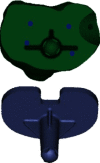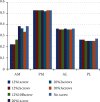Finite Element Assessment of the Screw and Cement Technique in Total Knee Arthroplasty
- PMID: 33123571
- PMCID: PMC7584958
- DOI: 10.1155/2020/3718705
Finite Element Assessment of the Screw and Cement Technique in Total Knee Arthroplasty
Abstract
Background: The screw and cement technique is a convenient method used to rebuild medial tibial plateau defects in primary total knee arthroplasty (TKA). The objective of this study was to perform a finite element assessment to determine the effect of different numbers of screws on the stability of TKA and to determine whether differences exist between two different insertion angles.
Method: Six tibial finite element models with defects filled with screws and cement and one model with defects filled only with cement were generated. Contact stresses on the surface of cancellous bone in different areas were calculated.
Results: Compared to the cement-only technique, the stress on the border of cancellous bone and bone cement decreased by 10% using the screw and cement technique. For bone defects with a 12% defect area and a 12-mm defect depth, the use of 1 screw achieved the greatest stability; for those with a 15% defect area and a 20-mm defect depth, 2 screws achieved the greatest stability.
Conclusions: (1) The screw and cement technique is superior to the bone cement-only technique. For tibial defects in which the defect area comprises a large percentage but the depth is less than 5 mm, the screw and cement technique is recommended. (2) Vertical screws can achieve better stability than oblique screws. (3) Screws should be used in moderation for different defects; more is not always better.
Copyright © 2020 Chong Zheng et al.
Conflict of interest statement
All of the authors of this article claim no conflicts of interest.
Figures







Similar articles
-
The optimal angle of screw for using cement-screw technique to repair tibial defect in total knee arthroplasty: a finite element analysis.J Orthop Surg Res. 2022 Jul 26;17(1):363. doi: 10.1186/s13018-022-03251-w. J Orthop Surg Res. 2022. PMID: 35883149 Free PMC article.
-
[Relationship between screw numbers and severity of tibial bone defect in primary total knee arthroplasty].Zhongguo Gu Shang. 2016 May;29(5):415-20. Zhongguo Gu Shang. 2016. PMID: 27505956 Clinical Trial. Chinese.
-
Biomechanical comparison between metal block and cement-screw techniques for the treatment of tibial bone defects in total knee arthroplasty based on finite element analysis.Comput Biol Med. 2020 Oct;125:104006. doi: 10.1016/j.compbiomed.2020.104006. Epub 2020 Sep 17. Comput Biol Med. 2020. PMID: 32971324
-
Difference Between Screw Cement Filling and Adequate Osteotomy With Thick Liner for Primary Total Knee Arthroplasty in Patients With Rand IIb Tibial Defects.J Arthroplasty. 2023 Aug;38(8):1510-1515. doi: 10.1016/j.arth.2023.02.004. Epub 2023 Feb 10. J Arthroplasty. 2023. PMID: 36773662
-
Review article: Treatments for bone loss in revision total knee arthroplasty.J Orthop Surg (Hong Kong). 2012 Apr;20(1):78-86. doi: 10.1177/230949901202000116. J Orthop Surg (Hong Kong). 2012. PMID: 22535817 Review.
Cited by
-
Primary total knee arthroplasty in patients with a significant bone defect in the medial tibial plateau: Case series and literature review.Int J Surg Case Rep. 2023 Sep;110:108779. doi: 10.1016/j.ijscr.2023.108779. Epub 2023 Sep 2. Int J Surg Case Rep. 2023. PMID: 37666156 Free PMC article.
-
Application strategy of finite element analysis in artificial knee arthroplasty.Front Bioeng Biotechnol. 2023 May 17;11:1127289. doi: 10.3389/fbioe.2023.1127289. eCollection 2023. Front Bioeng Biotechnol. 2023. PMID: 37265991 Free PMC article. Review.
-
Finite element analysis and biomechanical study of "sandwich" fixation in the treatment of elderly proximal humerus fractures.Front Bioeng Biotechnol. 2024 Jul 8;12:1425643. doi: 10.3389/fbioe.2024.1425643. eCollection 2024. Front Bioeng Biotechnol. 2024. PMID: 39040497 Free PMC article.
-
The optimal size of screw for using cement-screw technique to repair tibial defect in total knee arthroplasty: A finite element analysis.Heliyon. 2023 Feb 28;9(3):e14182. doi: 10.1016/j.heliyon.2023.e14182. eCollection 2023 Mar. Heliyon. 2023. PMID: 36923849 Free PMC article.
-
Creating Perforations in the Sclerotic Region of the Proximal Tibia During Total Knee Arthroplasty to Enhance Prosthesis Stability.Orthop Surg. 2025 May;17(5):1397-1405. doi: 10.1111/os.70025. Epub 2025 Mar 19. Orthop Surg. 2025. PMID: 40104929 Free PMC article.
References
-
- Matteo Fosco R. B. A. Luca Amendola, Management of Bone Loss in Primary and Revision Knee Replacement Surgery. 2012.
-
- Macaulay W., Saleh K., Miric A., Sculco T. P. Management of bony deficiency in primary and revision total knee arthroplasty. Techniques in Orthopaedics. 1999;14(4):315–322. doi: 10.1097/00013611-199912000-00008. - DOI
-
- Frehill B., Crocombe A., Cirovic S., Agarwal Y., Bradley N. Initial stability of type-2 tibial defect treatments. Proceedings of the Institution of Mechanical Engineers. Part H. 2009;224(1):77–85. - PubMed
MeSH terms
Substances
LinkOut - more resources
Full Text Sources
Medical

